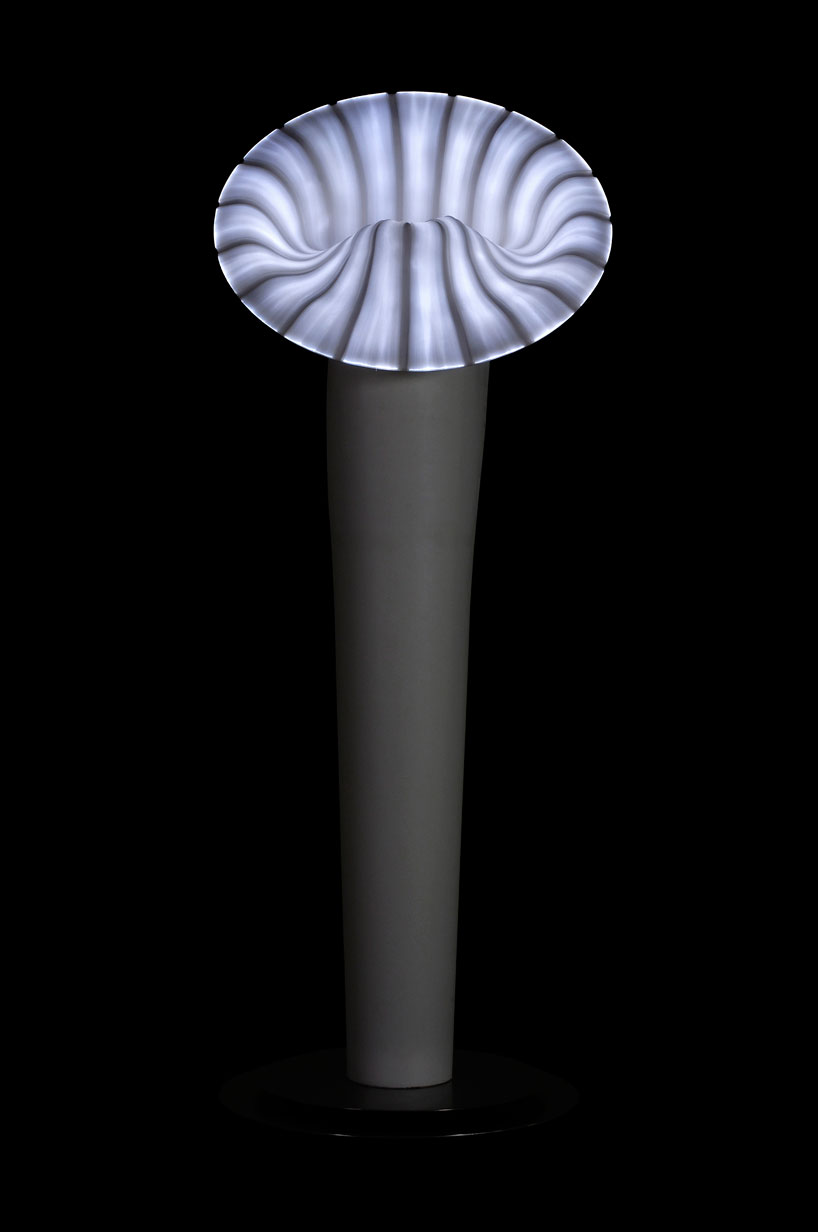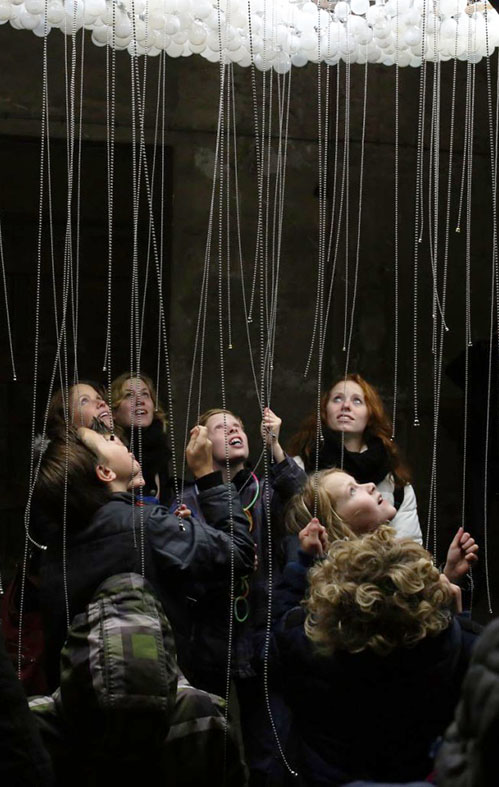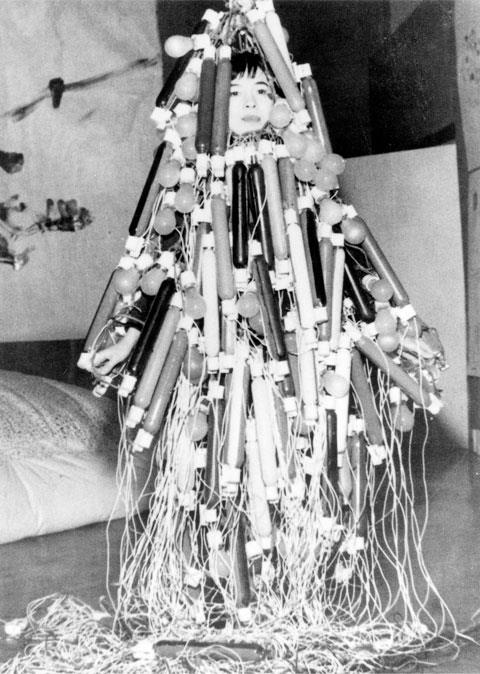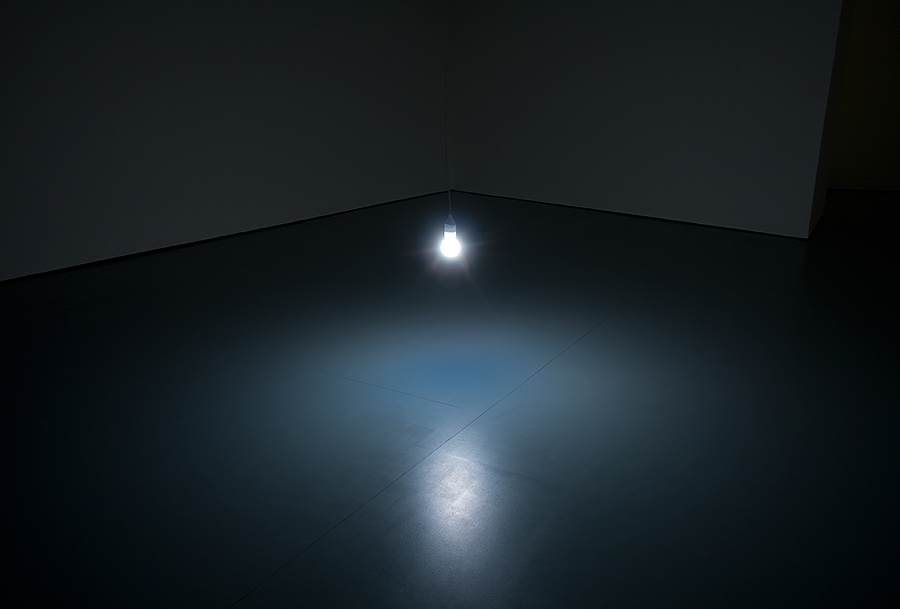


Bernardi Roig
NO/Escape
Mallorcan artist Bernardi Roig (b. 1965) installs six sculptural works in unexpected interior and exterior spaces, challenging visitors to rethink the definition of the museum. Roig draws parallels between his and Honoré Daumier’s works, both of which offer poignant social commentary. Roig addresses the existential dualities of entrapment and liberation, blinding and illumination, absence and presence. Typical of the artist’s work are the cruel-looking white plaster figures cast from real people, often cornered or crushed against walls or twisting in pain. By including the element of light—whether a single light bulb, neon tubes, or fluorescent lights—Roig’s work blends minimalist forms with highly charged expressions of anxiety and loneliness.

fabric | ch
Perpetual (Tropical) Sunshine
Perpetual (Tropical) Sunshine is an architectural, climatic and temporal installation. Thanks to a “screen” composed of several hundred infrared light bulbs, Perpetual (Tropical) Sunshine retransmits the journey and intensity of the sun as perceived on the 23rd parallel south, according to information transmitted live by weather stations all around the Tropic of Capricorn. Perpetual (Tropical) Sunshine thereby creates a displaced architectural space, which confronts the visitor with an abstract form of day and endless summer. It represents the increasingly artificial nature of our environment and suggests a form of “static mobility” or “displaced tropicality”.

GEBHARD SENGMÜLLER
parallel image
This work consists of 2500 magnetic wire cables that connect an emitter (one square meter made of epoxy resin) that consists of a 50 × 50 grid with photo sensors that have their counterparts in the receiver with a grid of bulbs. Thus the sensors detect the light and transmit in parallel each pixel (“image element”) with its corresponding brightness effect to the light bulb in the receiver. Unlike conventional electronic image transmission procedures, “A Parallel Image” uses a technologically transparent procedure, transmitting to the viewer a correspondence between the real world and its transmission.

GeeksArt
Wavelet
It uses the changing light to mimic the flowing water. Wavelet is composed of 1,300 light-responsive light bulbs. Each light bulb is designed in an arc shape, which gives the light wave a distinct direction. Each of the teardrop-shaped light bulbs is embedded with custom-made electronics that detect and react to changes in light and colour. When any of the light bulbs detect a change in colour or light, it displays the colour accordingly. When any of of the lights are turned on, the adjacent light bulbs react to the light change and the light waves automatically expand out to the very edge of the installation. From a single source of light, waves spread out like a series of dominoes. The random variable patterns created give a pleasant surprise to the audience.

RAFAEL LOZANO-HEMMER
Рафаэль Лозано-Хеммер
拉斐尔·洛萨诺 – 亨默
ラファエル·ロサノ=ヘメル
라파엘 로자노
רפאל לוזאנו, המר
Pulse Room
Pulse Room is an interactive installation featuring one to three hundred clear incandescent light bulbs, 300 W each and hung from a cable at a height of three metres. The bulbs are uniformly distributed over the exhibition room, filling it completely. An interface placed on a side of the room has a sensor that detects the heart rate of participants. When someone holds the interface, a computer detects his or her pulse and immediately sets off the closest bulb to flash at the exact rhythm of his or her heart. The moment the interface is released all the lights turn off briefly and the flashing sequence advances by one position down the queue, to the next bulb in the grid. Each time someone touches the interface a heart pattern is recorded and this is sent to the first bulb in the grid, pushing ahead all the existing recordings. At any given time the installation shows the recordings from the most recent participants.

BINA BAITEL
Pull over
French-israeli-swedish architect-designer bina baitel‘s lighting transcends the interaction between light and material, combining technological innovation with french handcraft. Her newest collection of lighting objects is commissioned and produced by nextlevel galerie in paris.‘Pull-over’: baitel’s previously designed ‘pull-over’ tactile luminaire is now also being produced by nextlevel gallery. The skin of the design is a variable luminous source thanks to its flexible nature – the light bulb, dimmer and lampshade are one.

Caitlind r.c Brown & Wayne Garrett
Cloud
The hand-bent steel substructure of the sculpture is covered in a skin of incandescent light bulbs (new and burnt out), and rear-lit from within by 250 compact fluorescent bulbs, pulling a total power of approximately 20 amps (the equivalent of two household outlets ).Each of these bulbs is attached to a pull-string, allowing viewers to control the illumination of the structure – like lightning in the CLOUD above them.

MYEONGBEOM KIM
МИЕОНГБЕОМ КИМ
김명범
Myeong Beom Kim is from Seoul, Korea. He produces otherworldly installations and sculpture works that juxtapose man-made elements with nature to create surreal dream spaces. Utilising suspension as a common motif, his works are constantly poised in a state of ambiguous wonderment. Within his installations, living things are held inside the fragile confines of light bulbs and helium balloons replace tree foliage, literally uplifting the tree and its roots.

TOYO ITO
تويو ايتو
伊东丰雄
טויו איטו
伊東豊雄
도요 이토
Tower of Winds
During the day the perforated metal panels that cover the Tower of Winds reflect the city image and make the design appear humble and simple. But during the night, it gets lit up in an ever-changing combination of light intensity and colors. Using computer software, the lighting follows the wind speed and noise levels changing the Tower’s appearance accordingly. The Tower of Winds features more than 1300 light bulbs and 42 flood lights and neon rings (on each floor). The small lights change their colors according to the wind’s noise level and the rings change their intensity according to its speed.
Basically, the Tower of the Winds by Toyo Ito is a wind indicator in a constant relationship with the city and the natural environment, a junction between the two. It is placed at the train station area, welcoming the passengers arriving in Yokohama and its functional role is accommodating another natural element. Surprisingly the Tower of Winds houses the water tanks for the air-conditioning system of the underground mall below. The Tower is not a new construction, but a re-designing of an old concrete tower that already existed there since the ‘60s.


ANNE HARDY
Residual Balance
The type of objects she chooses have ranged from large antlers, brightly coloured cables, old Christmas trees, light bulbs, American basketballs, orange balloons, scientific test tubes and even butterflies. Hardy puts these everyday objects together and transforms them into unusual, almost dreamlike, environments which can be unnerving with their themes of abandonment and desolation.

ATSUKO TANAKA
Electric Dress
«‹Electric Dress› is a powerful conflation of the tradition of the Japanese komono with modern industrial technology. Prior to her conception of this work, Tanaka had appeared in a larger than-life paper dress that was peeled away layer by layer, not unlike the peeling away of Murakami’s paintings; she was ultimately disrobed to a leotard fitted with blinking lights. Tanaka began to envision ‹Electric Dress› in 1954, when she outlined in a small notebook a remarkably prophetic connection between electrical wiring and the physiological systems that make up the human body. (…) After fabricating the actual sculpture, she costumed herself in it in the tradition of the Japanese marriage ceremony. Hundreds of light bulbs painted in primary colors lit up along the circulatory and nerve pathways of her body.»
.

CHRISTIAN BOLTANSKI
基督教波尔坦斯基
בולטנסקי
クリスチャン·ボルタンスキー
Кристиан Болтански
Homage
R.I.P 1944-2021
Preoccupied with collective memory, mortality, and the passage of time, Christian Boltanski creates paintings, sculptures, films, and mixed-media installations that approach these themes in a range of styles, symbolic to direct. Boltanski often makes metaphorical use of found objects, as in No Man’s Land (2010), an enormous pile of discarded jackets set to the soundtrack of thousands of human heartbeats, suggesting the anonymity, randomness, and inevitability of death. In Monuments (1985), electrical bulbs cast a seemingly bittersweet light on pictures of child holocaust victims. Describing his interest in personal histories, Boltanski has said, “What drives me as an artist is that I think everyone is unique, yet everyone disappears so quickly. […] We hate to see the dead, yet we love them, we appreciate them.”

László Moholy-Nagy
Light Space Modulator
“This piece of lighting equipment is a device used for demonstrating both plays of light and manifestations of movement. The model consists of a cube-like body or box, 120 x 120 cm in size, with a circular opening (stage opening) at its front side. On the back of the panel, mounted around the opening are a number of yellow, green, blue, rot, and white-toned electric bulbs (approximately 70 illuminating bulbs of 15 watts each, and 5 headlamps of 100 watts). Located inside the body, parallel to its front side, is a second panel; this panel too, bears a circular opening about which are mounted electric lightbulbs of different colors. In accordance with a predetermined plan, individual bulbs glow at different points. They illuminate a continually moving mechanism built of partly translucent, partly transparent, and partly fretted materials, in order to cause the best possible play of shadow formations on the back wall of the closed box”. László Moholy-Nagy

Dan Flavin
Untitled (to Barnett Newman) two
Dan Flavin was an American artist and pioneer of Minimalism, best known for his seminal installations of light fixtures. His illuminated sculptures offer a rigorous formal and conceptual investigation of space and light, wherein the artist arranged commercial fluorescent bulbs into differing geometric compositions. “I like art as thought better than art as work,” he once said. “I’ve always maintained this. It’s important to me that I don’t get my hands dirty. It’s not because I’m instinctively lazy. It’s a declaration: art is thought.”

WANG YUYANG
왕 유양
artificial moon
Artificial Moon is a sculptural piece by Beijing-based artist Wang Yuyang constructed from hundreds of various compact fluorescent lightbulbs. At over 13 ft. wide (400cm) the piece is an imposing recreation of Earth’s moon, using strategically placed lights to mimic craters and other surface features. Its creation is also particularly poignant, as it was originally put on exhibit in Shanghai, a city that due to light pollution is often unable witness the actual moon moving through the night sky.
